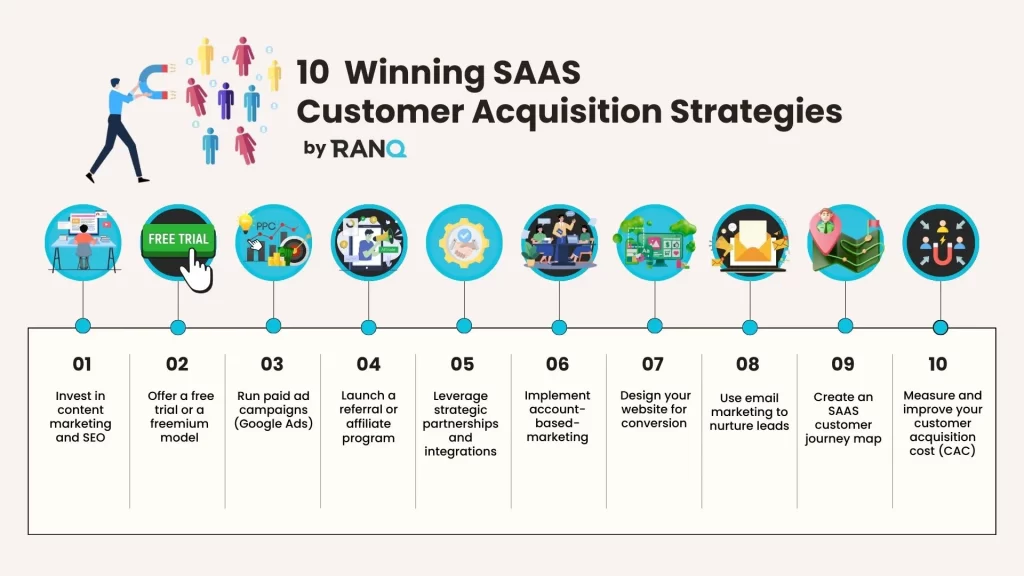As a SaaS business, you constantly struggle to attract more users without blowing your entire marketing budget in the process. Whether you’re a founder, a marketer, or a growth strategist, the goal is always to scale your SaaS customer acquisition strategy efficiently.
But have you considered the right strategies for your business’ particular needs? In this article, we’ll discuss ten winning SAAS customer acquisition strategies and the best use cases for each one.
What is a customer acquisition strategy?

A customer acquisition strategy is simply a set of plans and approaches designed to attract new customers and persuade them to try your product or service. It is about understanding your target audience, identifying their needs, and developing a plan to meet those needs. That comprehensive plan encompasses a variety of channels and tactics, including marketing, sales, and production.
There’s no one-size-fits-all choice for each SaaS business. Rather, you need to consider factors like who your ideal customers are, acquisition costs for that ideal customer, how much that customer spends on your products, and the speed with which your business is trying to grow. All of these questions will inform the right customer acquisition strategy for your business.
10 winning SAAS customer acquisition strategies

In the next section, we’ll discuss ten proven SaaS customer acquisition strategies that you can implement at your own company.
1. Invest in content marketing and SEO
One of the most foolproof methods of customer acquisition is through an alignment of content marketing and SEO (search-engine-optimization) practices. Content marketing is the process of creating and distributing quality content – blogs, videos, educational materials, landing pages – that will drive customers toward your service through increased brand awareness. Through consistent exposure and targeted content, you will be able to build long-term traffic and leads.
A strategy focused on content marketing and SEO will also lower your SaaS customer acquisition costs. SEO-optimized content will lead to more organic search traffic and less reliance on paid ads or other expensive, less consistent methods. Blog posts, lead magnets (educational materials offered to customers in exchange for their contact info), and product-led content will also help to convert leads into users or even customers. With six SEO-driven blogs a month, targeted keywords, and monthly upgrades, Ranq can transform your content marketing strategy and raise your exposure.
2. Offer a free trial or a freemium model
Another strategy is to offer a free trial version or a freemium model for your software. To differentiate the two terms, free trials are when you offer full-featured but time-limited experiences with your software. A the freemium model means that you offer limited features, but that version will always be free.
By allowing customers to try your product through different models, there’s little hesitation from anyone who would try your product. With freemium models, the software can stand independently and demonstrate its value. Companies like Dropbox, Slack, Hubspot, and Calendly all have freemium versions. To give a sense of conversion success rates, for freemium business models, conversion rates will be around 2–5% while free trial conversion rates fall between 10-20%.
It’s important to know when you should offer a free trial instead of a freemium version or opt for a different approach altogether. For instance, if you’re a startup, you don’t have the benefit of brand awareness to attract new customers, so freemium is a less viable option. And if you offer a free trial, you need to make users feel like they can’t go back to how they were solving their problems before they discovered your product. If the onboarding for your product isn’t tight and doesn’t immediately demonstrate its value, you may want to look at an entirely different acquisition strategy.
3. Run paid ad campaigns (Google Ads)
If you’re willing to pay for ad campaigns, you can also consider paid ads on places like Google Ads where users will see your services in organic searches or LinkedIn, where you can target people looking for certain kinds of jobs. These paid options are also known as search engine marketing. While your business is guaranteed to be placed highly – the customer acquisition cost is significantly more than other practices like SEO, which can lead to organic ranking.
When running paid ad campaigns, make sure to monitor their performance to see whether you’re getting the proper return on investment and leverage retargeting capabilities to maximize your exposure. Similarly, create an A/B test offer with the ad to see which version attracts more clicks.
4. Launch a referral or affiliate program
Especially if you’re a larger business, most of your sales will be based on referrals and affiliates. With a one-time investment, you can receive returns for years. Referral and affiliate programs incentivize product users, bloggers, and other influencers to promote or recommend your product to a friend.
With referrals, you are actively building trust with your customer base as they choose to tell their friends about your product. Your continued positive reputation is crucial to lowering your customer acquisition costs and creating more word-of-mouth growth for your business.
You can see these programs being leveraged effectively with companies like Dropbox, Typeform, and Airtable, which offer more storage, cash rewards, and a credit system with their referral programs. These programs also all offer dual-sided rewards so there’s more incentive for each person to continue referring others. The average referral conversion rate in most industries is about 2.3%, but it’s 30% higher in B2B SaaS referral contexts.
5. Leverage strategic partnerships and integrations
As a SaaS business, you should always be working to leverage strategic partnerships through bundles, other application integrations, and collaborations with other companies to promote each other’s products. This is an especially smart choice for startups lacking brand recognitions as the partnerships can help give them exposure. And these partnerships can have long-term benefits if they come through integration tools like Shopify App Store for mobile or Zapier Integrations for desktop. A concrete example of this would be integrating a CRM system like Salesforce with the automation capabilities of a company like Mailchimp.
6. Implement account-based-marketing
Another option is to implement account-based marketing (ABM), which is a strategy where marketing and sales teams collaborate to identify and target specific high-value accounts as opposed to aiming at larger categories of leads. In account-based marketing, you’ll choose the leads first, then build personalized campaigns to attract them.
Account-based marketing is riskier as it has a higher individual customer acquisition cost, but if it’s successful, it can lead to a higher customer lifetime value. ABM is most effectively used for high-value clients and enterprise accounts that can be big scores for your business. Tools like LinkedIn Sales Navigator and Hubspot also hone in on these high-quality leads and provide the information to SaaS businesses with premium subscriptions.
7. Design your website for conversion
Another strategy is to design your website with conversion rate optimization tactics. These features optimize your website so that users can find exactly what they’re looking for. That means not only clear call-to-action pages and trust signals that indicate credibility but also fast load times and easy navigation throughout your site.
A CRO-optimized website will also prioritize the Core Web Vitals, a set of Google metrics that assess a website’s performance in terms of loading speed, interactivity, and visual stability. Industry pros like Ranq specialize in these kinds of SEO and site optimizations.
8. Use email marketing to nurture leads
Another more organic strategy is email marketing and automation tools to nurture leads and convert users into customers. Automation tools like Mailchimp, ActiveCampaign, or Hubspot can all be used to introduce trials or gated content that can then turn into trials or demos with enough interest from the user. With your email marketing strategy, personalize the emails based on use case, industry, and customer size.
9. Create an SAAS customer journey map
Another strategy option is to create a SAAS customer journey map, which visualizes every touchpoint a customer has with your software, from their first interaction to retention and advocacy for the product. The stages of the customer journey map are awareness, consideration, activation, retention, and advocacy.
By mapping these experiences, you’ll be able to identify churn locations, upselling opportunities, and address areas where there are content gaps for the user. A simplified customer journey could be an organic search for your software that becomes a free trial or freemium version to an activation point where the user feels they need the product, and then that customer becomes an advocate for your brand.
10. Measure and improve your customer acquisition cost (CAC)
Lastly, you can focus your strategy on improving your customer acquisition cost. To measure your SaaS business’ customer acquisition costs, you will add your marketing costs, wages for marketing and sales, cost for marketing and sales software, cost for outsourced services, overhead, and divide that by the number of customers acquired.
The customer acquisition cost and lifetime value of a customer go hand-in-hand and will dictate the right strategy for customer acquisition by narrowing down your options. For instance, if you have a low LTV – You can’t do an aggressive sales approach if you don’t have the money to cover the salespeople’s wages. Tools like Baremetrics, Profitwell, or a good CRM can help automate your CAC numbers and help you decide the right strategy for you.
Optimizing your customer acquisition cost isn’t just about cutting costs, it’s about improving efficiency across every part of the sales funnel from awareness and interest to consideration and intent to evaluation and purchase.
Turn your SAAS customer acquisition strategy into growth with RANQ!
The most effective, winning SaaS customer acquisition strategy is built on data and experimentation. Depending on your product, audience, and the stage of your customer’s journey, consider how to best mix and match these customer acquisition strategies for your SaaS business.
Are you ready to grow in smarter ways? Talk to Ranq about scaling your SaaS business growth with curated content and top-shelf SEO practices.


